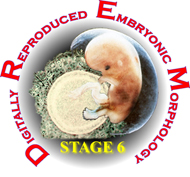

| Opening Screen | Embryo 7801 Figures | Download Section Images |
| Browse Sections | Flythrough Animations | Help / Instructions |
| 3D Models | Credits |
 |
||
|
Stage 6 embryos are characterized by the first appearance of chorionic villi. The amniotic cavity and secondary umbilical vesicle (yolk sac) are well defined by this stage. The embryo is in the presomite, disc period and axial differentiation is present for the first time. During this stage the embryonic endoderm and the gastrulation (primitive) streak first appear. The embryonic disc varies from 0.15 to 0.5 mm in maximum diameter. Initially, stage 6 embryos were believed to be about 13 days postfertilization, however, more recently, O'Rahilly & Muller (1996) have reexamined the ages assigned to the Carnegie stages and have estimated that stage 6 is ca. 17 days postfertilization. The stage is represented in the DREM databases by Carnegie embryo #7801 that has a grade of excellent. and was estimated to have an age of 13½ postovulatory days (Heuser, Rock & Hertig, 1945). Because the gastrulation (primitive) streak is present in the caudal part of the specimen it is classified as stage 6b. The embryonic disc is oval, measuring 0.22 mm in width and 0.253 mm in length. It is symmetrical and slightly convex dorsally. The thickness of the disc is nearly uniform measuring approximately 0.04 mm (Table of embryo dimensions). This specimen was prepared for microscopic examination in 1940. It was fixed initially in 70% alcohol followed by Bouin's fluid. It was then embedded in celloidin/paraffin and serially sectioned transverse to the longitudinal axis at 8 microns. More than 300 sections were cut through the implantation site with 31 sections through the embryonic disc. The sections were mounted on glass slides and stained with hematoxylin and eosin. In this database structures are identified on 50 sections through the embryonic disc and adjacent tissue. These sections are located on slides 11, 12 and 13. The morphology of this embryo is well documented in the literature. There are photographs of the implantation site and graphic reconstructions of the specimen. A drawing through the median plane showing the right half of the embryo was made from a model by Mr. J.F. Didusch in 1944. We have generated a digital reconstruction of the median longitudinal section corresponding to this drawing. The sections have been digitally restored and labeled, and can be viewed at three magnifications. [ Note: A fourth series of images show the embryo and surrounding tissues at the same magnification as zoom level 3.] Several 3D reconstructions have been produced from the aligned sections. Animations of these 3D reconstructions together with flythrough animations of the aligned sections are also included on the disks. For anyone who wishes to use them for other reconstructions, research or presentations, all of the original section images are available as individual .jpg files or as zip files . Instructions for using the disks can be found by going to the Instructions section from the opening screen. |
||